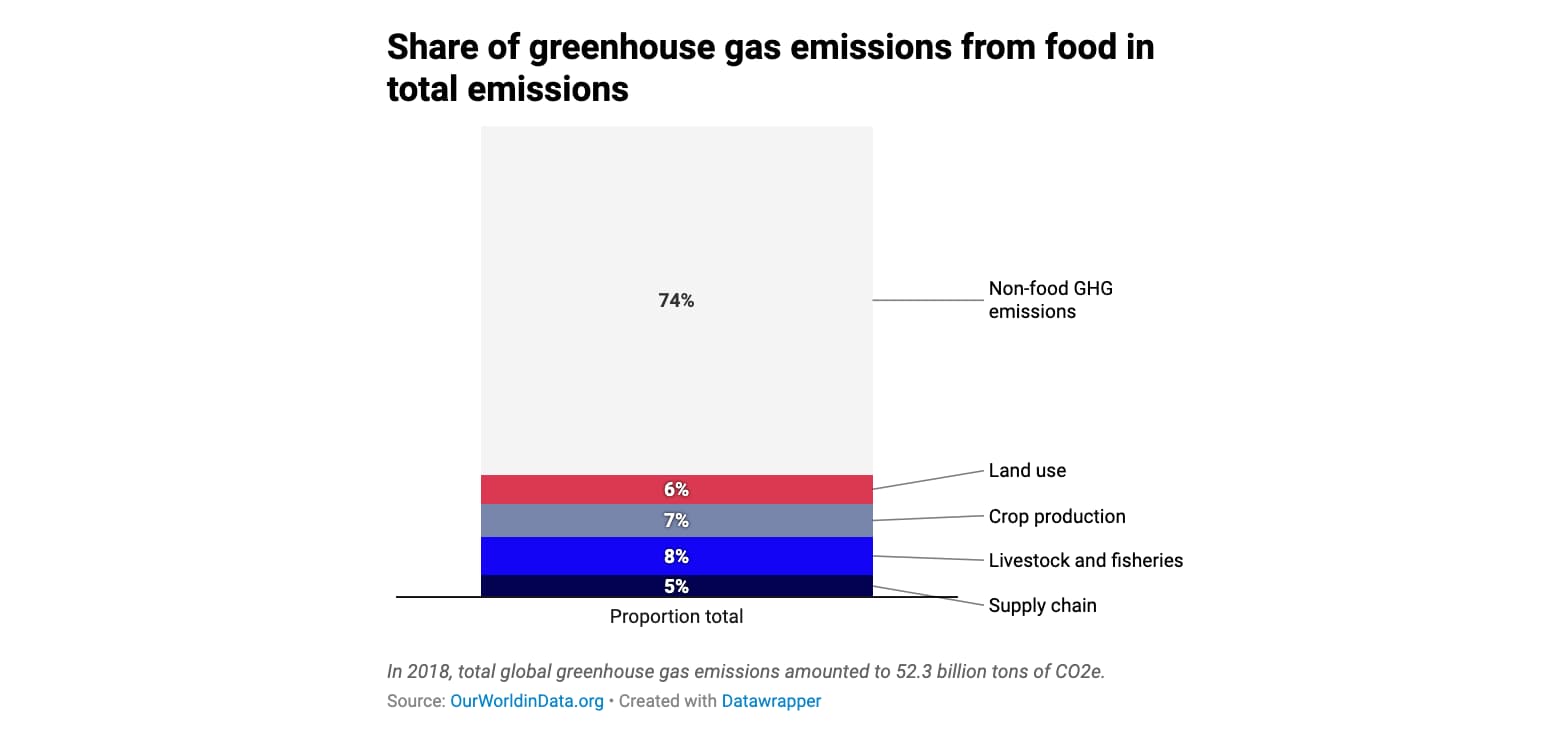When we compute carbon footprints, our customers are often surprised when we ask them questions about the types of meals that their employees usually take at lunchtime. After all, the way people eat is a private matter: the company has absolutely no say in that.
Why does it matter, then?
Although people’s eating habits are essentially personal choices made by individual people, carbon-conscious corporations should still have some level of awareness about them. One of the fundamental principles of carbon accounting is that all physical flows that allow the company to function properly should be counted. In this case, corporate emissions must include employee meals during their workday, regardless of the company’s meal policy: the usual shift for full-time employees may last between eight and ten hours, and sometimes even more, so they are expected to eat something during that time to sustain themselves.
This is critical in the first place because the entire food industry represents 26% of carbon emissions across the world, which makes it a critical point of attention for the Net Zero objective to be reached by 2050.

This is obviously a direct concern for agri-food companies, but all companies on the receiving end should still be aware of that, too. Granted, it is crucial to keep a sense of proportion: in an average industrial company, the vast majority of greenhouse gas emissions will stem from raw material purchases, their transportation, and from the factories’ electricity and fuel consumption. In this case, employee meals will only be a droplet in the company’s total carbon footprint: they will still be included in the carbon footprint computation for comprehensiveness, but it will not be a priority, either during the data collection process or in the company’s decarbonisation plan.
However, the situation is very different for some services companies – IT services, consulting … Those industries typically don’t need a lot of physical equipment to operate: only offices, computers, and servers. Because of that, and aside from exceptional circumstances – including frequent car or air travel – meals can represent up to forty percent of the total carbon footprint of those companies. In this case, to estimate their carbon footprint as precisely as possible, it is necessary to ask some questions about the employees’ eating habits.

How can my company act on it?
There are two main variables that affect the carbon emissions related to employee meals: the way that companies subsidize meals – if they do at all – and the type of meals that employees take.
Company cafeterias are often appreciated by employees, but they can also become particularly troublesome from a carbon footprint perspective. In many cases, for employee satisfaction, the food caterer may be obliged to offer several types of dishes every day, and to have them all available until very late into the service. It is impossible for them to accurately predict the number of people who will come every time, and which dish they will prefer, so they have to overshoot, even if it means having a lot of meals left over at the end of the service. If no specific action is taken (for instance, selling food for a rebate at the end of the service, or donating leftovers), this situation leads to a very high amount of food being wasted.

The other side of the equation is related to the actual meals that are served. Beef meat (along with meat from other ruminant animals) is particularly emissive for two reasons:
Because of the additional amount of farming needed (it takes eight kilograms of vegetables to get a kilogram of beef meat),
Because of direct methane emissions that occur during their digestion.
From this point of view, vegetarian meals are much more efficient: in total, they emit ten times as little carbon dioxide to produce. If we stick to meat-based meals, a meal with poultry should be preferred, since it is much less emissive than a meal with beef.
In addition to employee lunches, snacks, and beverages have their importance, too. To give some concrete examples, an espresso emits 49 gCO2e (from the moment coffee beans are grown, to the final preparation), and a single large latte emits up to 552 gCO2e, which is more than an entirely vegetarian meal.
This is why services companies that want to be environmentally conscious should have some awareness about the food served or consumed on their premises: employee meals are often the largest relative contribution to their carbon footprint, and depending on the type of food, there can be a very strong level of variation.
Meals in the workplace can be a very sensitive topic: in the end, the company’s means of action remain limited, since every employee is and should remain responsible for their dietary preferences. That being said, companies should remember that employee meals are still part of their corporate carbon footprint, and that their relative importance can become significant for services firms. By going from an average of five meat-based meals per week to only three, these companies can decrease their total carbon emissions by up to 10%.
In any case, to reduce corporate carbon emissions on a long-term basis, it is important to raise awareness on the topic of meals among employees.
Sources
Our World in Data. 2022. Food production is responsible for one-quarter of the world’s greenhouse gas emissions. [online] Available at: https://ourworldindata.org/food-ghg-emissions [Accessed 10 February 2022].
Poore, J. and Nemecek, T., 2018. Reducing food’s environmental impacts through producers and consumers. Science, 360(6392), pp.987-992.
Berners-Lee, M., 2021. How Bad Are Bananas?: The Carbon Footprint of Everything.
